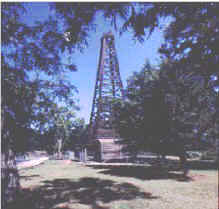Economic Developments in the Early 1900s
In the early statehood era, Oklahoma’s economy depended on farming and
livestock-raising in addition to coal mining. But as the automobile revolution occurred (1900
to 1930), the petroleum industry boomed. Workers custom-made all the early autos. That
meant that each one was different from all others. Because they were custom-made, they
were very expensive. They were just toys for the rich. Some car-makers wanted to find a
way to produce cheaper automobiles that average people could afford.
The leader of the automobile industry who first reached the mass market was Henry Ford.
He founded his Ford Motor Company in 1903. Using assembly-line techniques and interchangeable
(standardized) parts, he produced a cheaper automobile. By 1913, Ford marketed a car that
cost $500. By 1920, he had the cost down to $275 and reached the mass market. Other car
makers adopted Ford’s production techniques and also began to produce cheaper
products.
| As car-makers sold more and more automobiles, trucks and
buses, the Oklahoma petroleum industry grew and
became a large contributor to the
state’s economy. The industry had a long history. In 1859, in the Cherokee Nation
near Grand Saline, Lewis Ross tried to dig a water well. He got oil instead. His find went
almost unnoticed because Oklahoma was too far away from major oil markets at the time.
Much later, in 1897, the Cudahy Oil Company’s
Frank Phillips sunk a commercial
well near Bartlesville. Because there was no great market for the oil, he capped the well
until the Santa Fe Railroad came through the area. That allowed Phillips to ship his oil
all the way to the East Coast. In 1901, the Red Fork Field opened
near
Tulsa. That
city would one day be called the "oil capital of the world." Examples of other
new oil finds include: Glenn Pool near Tulsa, 1905; Cushing Field, 1912; and Healdton
Field, near Ardmore, 1913.
|

Replica of Oklahoma's first commercial oil well near Bartlesville (Photo
courtesy of Fred Marvel, Oklahoma Department of Tourism)
|
As the economy of Tulsa boomed, European immigrants and residents from
Pennsylvania and Ohio who had experience in the oil regions of those states
moved to Oklahoma. The population increased from 7,000 in 1907 to more than
72,000 by 1920. The oil boom town had quickly become the state�s second
largest city.

Additional Resources

Study Guide Questions:
- What were the main industries in Oklahoma at the time it became a
state?
- What impact did the automobile have on Oklahoma's economy?
- What happened to Lewis Ross?
- Who was Frank Phillips? What did Frank Phillips wait to happen
before he began pumping his oil?
- The Red Fork Field and Glenn Pool were near what city?
- What happened to Tulsa's population between 1907 and 1920?
Back to Top |